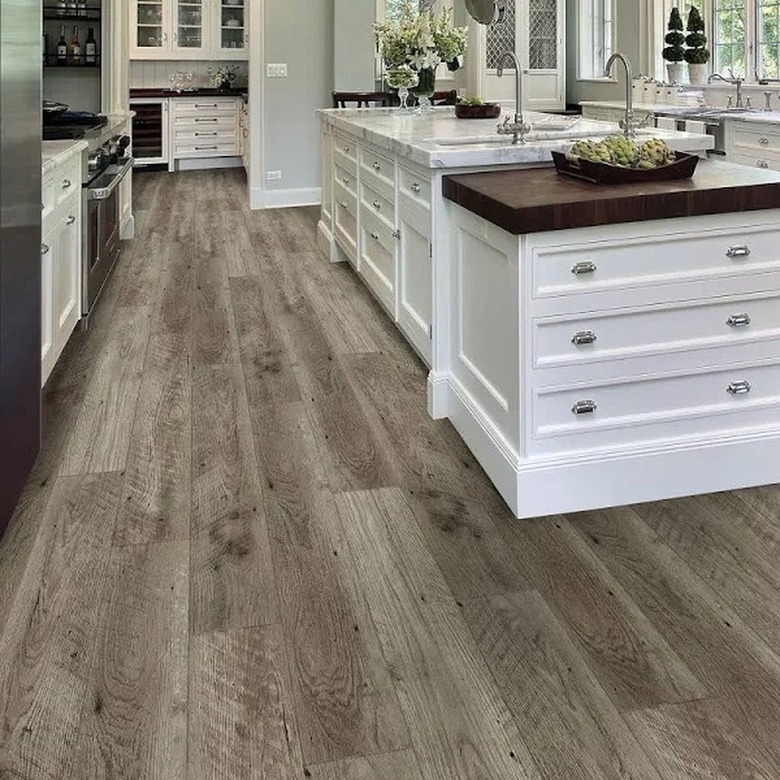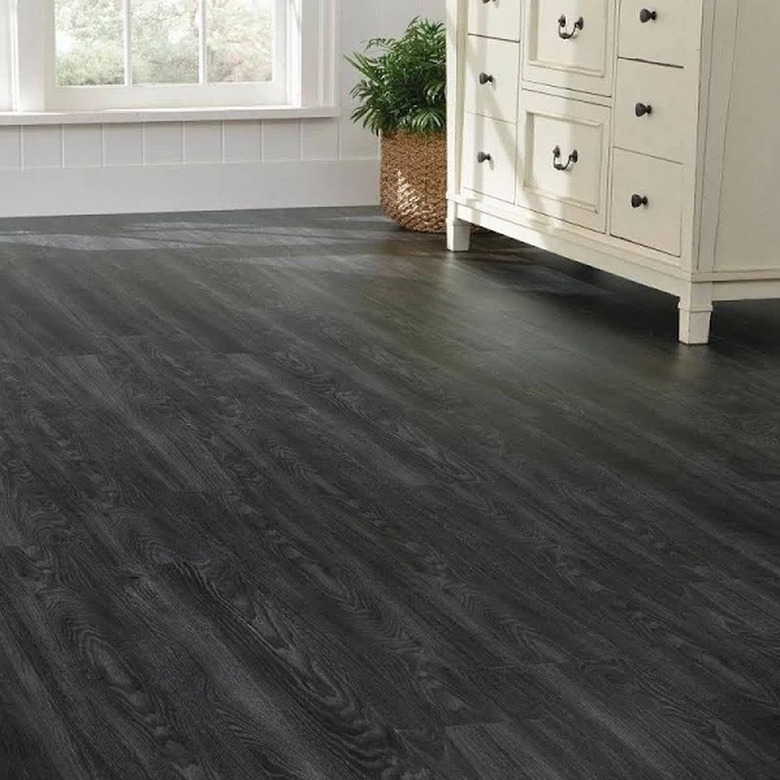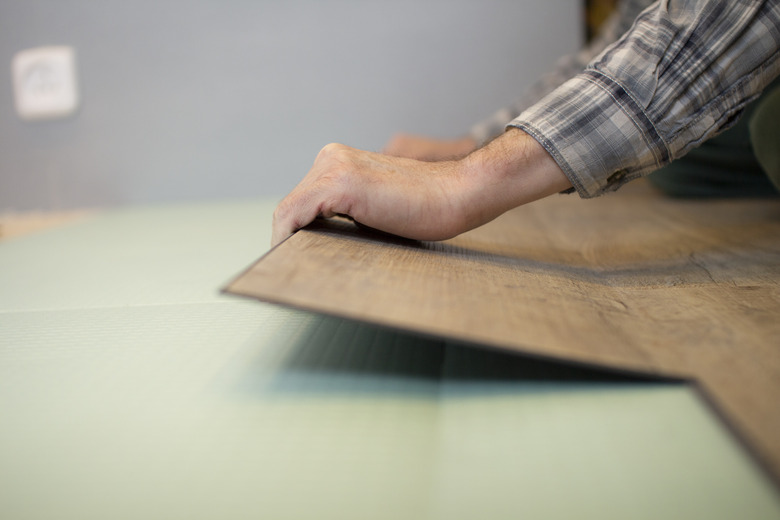Vinyl Flooring Tiles (LVT): What You Need To Know
We may receive a commission on purchases made from links.
If the term "vinyl flooring" makes you think of the dimpled 1970s puce-and-mustard-checked kitchen floor at your granny's, then you've got another think coming. Today's luxury vinyl flooring is a far cry from its forebears. Engineered for tough living but designed to be a durable-for-decades wow factor in your home, luxury vinyl flooring comes in easy-to-install tiles and planks. Old reputations die hard, but it's time to give due consideration to luxury vinyl tile if you're looking for a cost-effective flooring solution that can work with every design aesthetic in every room of the house.
What Is Luxury Vinyl Flooring Tile?
What Is Luxury Vinyl Flooring Tile?
Luxury vinyl flooring tile and planks offer products for a wide range of budgets with photo-real finishes while bringing all the moisture-resistant, long-wearing attributes of traditional vinyl flooring. Factoring in installation, luxury vinyl tiles can cost up to 75 percent less than using "real" tiles, but it takes a critical eye to spot the difference. The "tile" in "luxury vinyl tile" refers to their dimensions, not their appearance — you'll find them mimicking wood, stone, and much more.
The traditional wide roll of vinyl flooring is still a great option if you need a seamless floor for some reason. Glue-down and peel-and-stick vinyl tiles have been common for years, but luxury vinyl flooring uses modern printing technology to create a more versatile product. Luxury vinyl comes in both tiles and planks, the difference being the dimensions. It's a rigid product that is flat-packed for easier transporting and storage. Installation is easier than with traditional tile since LVT is easy to cut with a utility knife and is flexible.
It's also easier to work with for DIY installers. Unlike unforgiving sheet vinyl, which requires a perfect subfloor and often calls for professional installation, LVT can be floated over existing floors. This makes preparation simpler, cheaper, and more amenable to DIY installation. Plank or tile also means repairs can be made in the future if a section needs replacing due to scuffs or scratches from years of wear.
How Is LVT Made?
How Is LVT Made?
There's a layered process at work in the manufacturing of luxury vinyl flooring. Every tile has a base made of PVC that supports the central core. It's this core that dictates if LVT is water-resistant or waterproof. A rigid core, for instance, may be 100 percent waterproof. Next comes the photo layer, which is the digitally printed image that defines how your floors will look, so this is the layer that looks like travertine, old barn plank, river rock, or whatever you've chosen.
Next comes the wear layer, which is the one you want to investigate. This wear layer is typically 6 mils to 30 mils thick. Note that a "mil" is not a millimeter; it's a thousandth of an inch. Anything from 12 to 30 mils is considered commercial strength for high-traffic floors. From 6 mils to 12 mils is rated for residential use, but anyone with an active household and pets is advised to seek closer to 20 mils in the wear layer. Choosing over 20-mil-thick wear layers can mean losing clarity on printed designs, though.
You'll know if an LVT product is designed for a floating floor because the edges will have a "clickable" technology, sort of tongue and groove. This edge allows the pieces to interlock, removing the need to glue down the flooring. Whether your floor is suitable for a floated product, though, is another matter.
Common Dimensions for LVT
Common Dimensions for LVT
Like most types of flooring, you'll find luxury vinyl tile in all sorts of sizes, but 16 x 16 inches is most common. Other sizes include a variety of square and rectangular dimensions, like 12 x 24, 18 x 36, 18 x 18, and so on. Ask for a complete list of sizes for any product you like.
Thickness is a key consideration since the thicker the tile, the better the long-term performance will be. Typically, LVTs are 2 millimeters to 8 millimeters thick. In terms of how much of that is the actual wear layer, it helps to know that 40 mils is essentially 1 millimeter thick.
What Is Rigid Core LVT?
What Is Rigid Core LVT?
If you're keen on a floating floor, then you want a rigid core vinyl tile. That core is a composite of either powdered stone or wood combined with resins or plastic. This is denoted in the designation of WPC or SPC, which translate to "wood-polymer core" or "wood-plastic composite" and "stone-polymer core."
Have no fear; a wood-powder core does not mean the tile will look like wood. This WPC or SPC rigid core has no impact on the external design of the flooring tile. Despite being wood, even if water did come in contact with the core, the processes involved mean water still won't buckle or swell these tiles, so they're perfect anywhere you worry about moisture damage.
Upsides of Luxury Vinyl Tiles
Upsides of Luxury Vinyl Tiles
Installing flooring is no one's idea of how to spend a great day, so you want a product that's designed to last for years, and many luxury vinyl products now come with limited lifetime warranties. Durability is just one of the key points people love about vinyl tiles and vinyl planks.
- Safer: Nonslip surfaces mean it will be harder to do your "Risky Business" impersonation, but you also won't wipe out when you're
running to shut off the stove when a pot's boiling over. Also, bathrooms become
a little less dangerous too. - Ready for busy rooms: Being water-resistant or sometimes even waterproof
makes vinyl tiles ideal for kitchens, basements, bathrooms, and anywhere else
that wet, high-traffic floors exist. - Comfortable: When installed over plywood subfloor with a
good underlayment, LVT and LVP have just a little give and can be better for
those whose joints are sensitive to hard flooring. - Low maintenance: Sweep it and clean it regularly with a gentle vinegar-water solution and you'll
be sitting pretty for years to come. There's no need to seal these floors, wax them, or
polish them.
Downsides of Vinyl Flooring
Downsides of Vinyl Flooring
No matter how you slice it, LVT isn't good for the environment. They're made with PVC and sometimes phthalates, around which are increasing discussions on health and ecological impacts. Thus, LVT off-gases after installation, which is sometimes problematic for those with environmental sensitivities. That "new-car smell" is an example of off-gassing. Off-gassing isn't permanent, but it's not uncommon for odors to be "extreme" for two to five weeks after installation. Off-gassing isn't exclusive to vinyl floors, though, as many household materials emit VOCs, particularly just after installation.
Common downsides also include possible damage from dents when you drop things or stains when the flooring comes into contact with certain chemicals. Fading from sun exposure is also a problem, so look for products with UV protection. These are issues in any flooring warranty, as they're common throughout the industry. At this point, recycling vinyl is problematic too, but industry watchers are hopeful that changes in the future.
Lastly, there's no getting around vinyl's image problem. It doesn't matter that it looks great and performs well — it's still vinyl. Resalewise, it doesn't have the cachet of tile, bamboo, hardwood, or even cork. If you're selling in 10 years and you get a decade out of a product you loved and got a deal on and it still looks good when you're listing the home, isn't that all you need in terms of resale appeal?
You Can Float LVT If…
You Can Float LVT If...
Whoever wrote the horror movie "What Lies Beneath" probably worked in home improvement and flooring installation. Floating floors are popular as a DIY project because their click-lock installation can be speedy and simple thanks to no adhesive being needed. The right flooring can play substrate to a new floor if it meets all the right criteria, like being solid. If the substrate isn't up to the job, though, you run the risk of echoing its shortcomings in your new, expensive flooring. If you're not sure your floors are sufficient, then a new layer of 1/4-inch plywood underlayment may be in your future.
- Floor integrity intact: LVT can be installed over wood subflooring, concrete, and some existing flooring materials. Floating floors aren't designed to hide flaws; subfloor issues of any kind will inevitably have consequences in terms of buckling, warping,
or telegraphing flaws over time. - No seams or tight seams: Gaps in the subflooring or old flooring are problematic for LVT, as are raised or open seams.
- Free of imperfections: Bumps or holes in the substrate can create problems down
the line. Bumps must be sanded and leveled, and any gaps or holes should be
filled. - Clearance required: Doorways, closets, drawers, and
baseboards can be a problem with a new floor because if the floor is too high, it will
impede their function. "Close enough" might be decidedly not close
enough, so measure twice in many, many spots because what is
true in one corner won't be true on the other side of the room.
Installing Over Concrete
Installing Over Concrete
While LVT is moisture-resistant or even waterproof, it's never recommended to install or float LVT over bare concrete floors. Water that surfaces can leach chemicals from concrete that can damage the flooring from beneath. A moisture barrier will protect your floor; some underlayments can provide this, but some will require a separate moisture barrier.
With any LVT installation, sound-dampening and cold-blocking underlayment is generally recommended because it will make your floors quieter, better insulated, and kinder to feet and joints over time.
Installing Over Hardwood and Laminate
Installing Over Hardwood and Laminate
Hardwood floor seems like a great base; after all, subfloors are generally wood too. However, you'll need to inspect the whole floor to see if it's suitable or if any existing seams are lifting or separating. Previous water damage will have caused the boards to become swollen or may have warped them. For laminate, this is even more true, but laminate is likely to be a floating floor installation too. If so, you should remove floating laminate; it won't be much more work, but it will ensure more control over the end result.
Installing Over Tile
Installing Over Tile
Some manufacturers of thin luxury vinyl products will advise against floating over highly embossed existing flooring because even that can show sometimes. So, floor tiles and grout lines can be a problem, as can "natural" surfaces that aren't completely flat. Those textures may show through — or "telegraph" in flooring parlance — to the new surface. Using a leveling compound to smooth out those grout lines is recommended. Provided you've done a great job of leveling grout lines, good-quality LVT shouldn't require underlayment over tile.
VOCs and Vinyl Flooring
VOCs and Vinyl Flooring
"Caveat emptor" is the watch word for any consumer of any flooring product. Some amount of VOCs are a given with most home improvement products. Adhesive adds a lot of VOCs to vinyl flooring, so a floating floor can eliminate VOCs from the process if they're a concern.
Even with low-VOC products, some steps can help reduce noxious emissions from flooring:
- Air them out: Unpack vinyl floor tiles as far in advance
as possible and allow them to ventilate before installation. - Think air quality: Keep windows open during and after
installation for a few weeks. Ideally, use an air purifier in the room as well. - Discard packaging: The packing has absorbed VOCs too, so as soon as
you unpack the tiles, ditch the packaging. - Keep it clean: Keep the floor dust- and dirt-free with
frequent sweeping and vacuuming. Remember that VOCs can transfer via touch, so
particulate on the floor picks up VOCs too.


